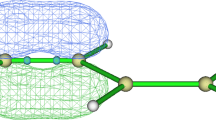Abstract
Connections are given between the theoreticalπ-electron theory in an ordinary atomic orbital basis and semiempirical theories in an orthogonalized basis, neglecting terms of third order. An expression is derived for a one-electron operator with the properties, usually assigned to the effective Hamiltonian of the Hückel method. The non-local part of this operator is shown to give only small contributions also for heteromolecules and lone pairs. Not only short-range forces but also long-range forces, originating from the exchange operator. contribute essentially to the effective bonding. Numerical applications have been madee.g. to aniline andp-benzoquinone.
Zusammenfassung
Es wird der Zusammenhang zwischen einer reinenπ-Elektronentheorie mit Atomeigenfunktionen als Basis einerseits and semiempirischen Theorien mit orthogonales Basis andererseits aufgezeigt, wobei Glieder dritter Ordnung in Überlappungsintegralen vernachlässigt werden. Dabei läßt sich ein Einelektronenoperator mit den Eigenschaften, die für gewöhnlich für den effektiven Hamiltonoperator der Hückel-Theorie postuliert werden, finden. Sein nichtlokaler Anteil liefert nur geringe Beiträge für Heteroatome und einsame Elektronenpaare. Für die Bindung sind neben den Kräften des Austauschoperators mit kurzer Reichweite auch weitreichende von Bedeutung. Numerische Werte für Anilin undp-Benzochinon werden gegeben.
Resume
Des connections entre la méthode théorique des électrons z sur base d'orbitales atomiques ordinaires, et des théories semiempiriques sur une base orthogonalisée sont données, en négligeant les termes du troisième ordre. On dérive une expression pour un opérateur monoélectronique ayant les propriétés attribuées usuellement à l'opérateur hamiltonien effectif de la méthode de Hückel. On montre que la partie non-locale de cet opérateur ne donne que de contributions petites, même pour les hétéroatomes et les paires libres d'électrons. Non seulement les forces à portée courte, mais aussi celles à portée longue dérivant de l'opérateur d'échange, contribuent essentiellement à Ia liaison effective. Des applications numériques, p.e. pour l'aniline et lep-benzoquinone, ont été effectuées.
Similar content being viewed by others
References
Del Re, G., andR. G. Parr: Rev. mod. Physics35, 604 (1963).
Fischer-Hjalmars, I.: Tetrahedron19, 1805 (1963).
—: J. chem. Physics42, 1962 (1965).
Gladney, H. M.: Theoret. chim. Acta1, 245 (1963).
Löwdin, P.-0.: J. chem. Physics18, 365 (1950).
- Proc. intern. Conf. theoret. Physics Kyoto, Tokyo, 1953, 599 (1954); - Svensk Kem. Tidskr.67, 380 (1955). - Advan. Physics5, 111 (1956).
McWeeny, R.: Molecular Orbitals in Chemistry, Physics, and Biology, p. 305, edited byLöwdin, P.-O., andB. Pullman. New York: Academic Press Inc. 1964.
Mulliken, R. S.: J. Chim. physique46, 497 (1949).
- Rep. Symp. molec. Physics Nikko, Japan, 1953, 18 (1954).
[10]—: J. chem. Physics23, 1833, 1841 (1955).
Orloff, M. K., andD. D. Fitts: J. Amer. chem. Sec.85, 3721 (1963).
Pariser, R., andR. G. Parr: J. chem. Physics21, 466, 767 (1953).Parr, R. G., andR. Pariser: J. chem. Physics 23, 711 (1955).
Parr, R. G.: J. chem. Physics19, 799 (1951).
[14]—: Quantum theory of molecular electronic structure. New York-Amsterdam: W. A. Benjamin, Inc. 1963.
Peacock, T. E.: J. chem. Soc. (Lond.)1959, 3241.
Pople, J. A.: Trans. Faraday Soc.49, 1375 (1953); Proc. Roy. Soc. (Lond.)A 68, 81 (1955); J. physic. Chem.61, 6 (1957).
Ruedenberg, K.: J. chem. Physics34, 1861 (1961).
Silverstone, H. J., H. Joy, andM. K. Orloff: In course of publication. The author is indebted to Dr.Silverstone for the privilege of reading the manuscript prior to publication.
Skancke, P. N.: Acta chem. Scand.18, 1671 (1964).
Author information
Authors and Affiliations
Additional information
Aided by a research grant to The Johns Hopkins University from the Petroleum Research Fund of the American Chemical Society.
Rights and permissions
About this article
Cite this article
Fischer-Hjalmars, I. Connections between currentπ-electron theories. Theoret. Chim. Acta 4, 332–342 (1966). https://doi.org/10.1007/BF01129647
Received:
Issue Date:
DOI: https://doi.org/10.1007/BF01129647




